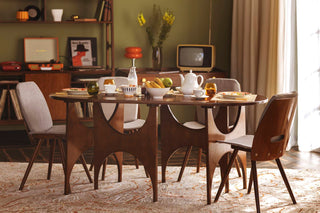Vintage interior design is a style that combines the elegance of the past and modern comfort.
Its main focus is on authentic or aged objects, natural materials, and subtle colors. Vintage interiors not only add warmth and coziness to a home, but also reveal the owner's emotional connection to objects that hold a story.
The main goal of this style is to create an atmosphere in which each element has its own meaning and value.
So, what elements should you choose to achieve harmony at home?
For a stylish accent in your home, geranamie.lt Art Deco style decor is perfect.
Geranamie.lt offers Art Deco style decor for interiors
- Paintings, screens and wall clocks are exclusive Art Deco accents that give the space a sense of luxury, elegance and completeness;
- Original Art Deco style paintings on canvas – author's works and reproductions of works by famous artists, reflecting the aesthetics of this style;
- High-quality 240 g/m² canvas - natural, textured cotton features rich colors, shine, and pattern detail;
- Modern printing technology – bright, long-lasting colors and excellent resistance to environmental influences;
- Eco-friendly, odorless paints – products with GreenGuard Gold certification, suitable even for sensitive home environments;
- Ready to use immediately – paintings and wall clocks come with a hanging system, screens with legs, so you can immediately apply the decorative elements to your home;
- Fast delivery throughout Lithuania – orders are fulfilled within 5–10 business days.
The main features of a vintage interior
Colors
The vintage interior is dominated by warm colors: beige, gray, lilac, yellow, moss green.
These colors create a calm, subtle atmosphere, while brighter accent colors, such as burgundy red or navy blue, are applied in smaller details, such as cushions, curtains or decorations.
This creates harmony – one light color scheme dominates, and brighter shades are used only as accents.
Furniture
Vintage furniture is a unique design, made of natural wood, with delicate ornaments, curved corners and tapered legs. The furniture can be antique or restored, but most importantly, it has history and character.
Vintage furniture blends perfectly with accents from other styles, giving the space a sense of personality and sophistication.
Examples include wooden chairs, sofas, or tables covered in modern fabrics. This reflects classic shapes and contemporary design elements.
Materials
The interior is dominated by wooden furniture made of oak, teak, and walnut, with natural cracks and groove patterns that give the interior warmth and coziness.
Additional materials used include ceramics, porcelain, glass and brass, which also help create a warm atmosphere that tells the owner's story. Appropriate textiles - tapestry, linen, wool - not only add aesthetics, but also provide textural depth.
Decorations
Vintage interiors are full of decorations that have not only aesthetic but also emotional significance.
The walls are beautifully decorated with old photographs, portraits and paintings in ornate frames. Antique music boxes, crystal dishes and porcelain figurines are also used, which not only decorate the space but also tell their own story.
This interior looks natural and alive – there are no cold, impersonal details here.
How to implement a vintage interior?
Furniture selection
Antique furniture can be adapted to modern needs – by restoring it, changing its upholstery or details, but doing so while maintaining its authenticity. This allows you to create a balance between the charm of the past and modern functionality.
Many furniture manufacturers offer modern versions inspired by vintage designs, so adapting furniture to your interior will not be a complicated process.
Combining colors and shapes
Muted colors should dominate the space, and bright accents should be carefully integrated into the space.
The combination of shapes in a vintage interior is also important. Both graceful, rounded lines and sharp geometric shapes need to be balanced so that the space does not look too crowded.
Textiles and lighting
Natural fabrics such as linen, wool and tapestry are used for furniture upholstery and curtains. Curtains are usually long, draped and have subtle patterns, which add warmth and coziness to the space.
Lighting is also an important element. For a vintage-inspired interior, consider fabric-shaded lamps, crystal chandeliers, or lamps with metal accents. The light should be warm to give the space a warm and cozy feel.
The main mistakes when combining vintage at home
|
Error |
Solution |
|
Too many antiques (too cluttered interior) |
Choose a few authentic pieces that have historical value and combine them with modern elements. This will help keep the space open and modern, avoiding chaos. |
|
Unsuitable materials |
Plastic and synthetics are not suitable for vintage interiors. Use natural materials: wood, ceramics, porcelain, wool, tapestry. This will give the interior the authenticity and textural depth that is characteristic of the vintage style. |
|
Too many bright colors |
Choose a balanced palette with muted colors as a base and use brighter accents only in small details, such as cushions or artwork. |
|
Disproportionate furniture |
Furniture that is too big in a small room creates clutter, while furniture that is too small disappears and does not give the room a sense of completeness. Choose furniture that is proportional to the size and function of the room. |
|
Inappropriate combination of furniture from different periods |
Combining furniture from different periods can create a dissonance in style. For harmony, combine furniture with similar shapes, colors, and materials. This will help create a coherent and attractive space where vintage and modern styles merge without chaos. |
